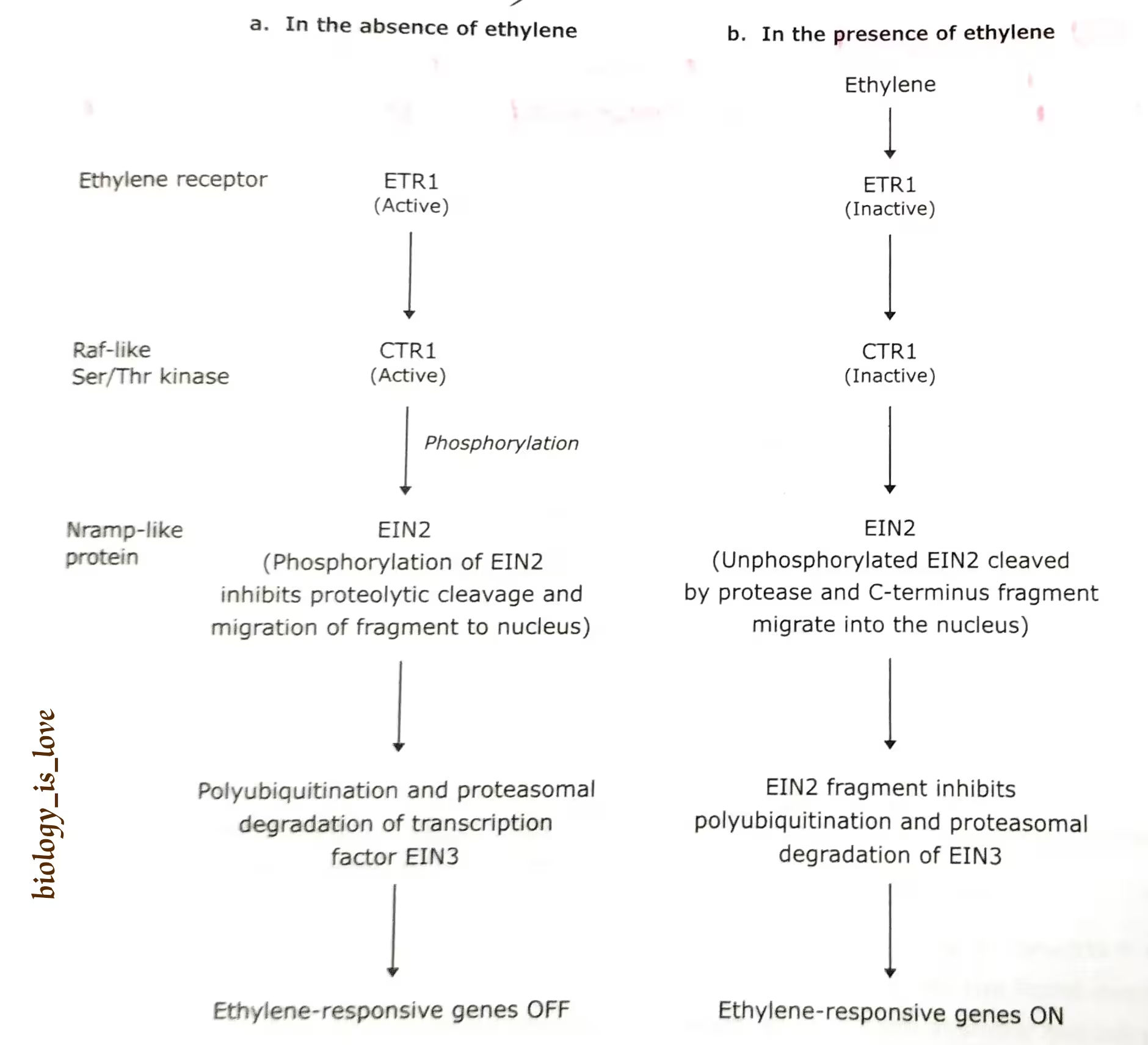Table of Contents
Ethylene signaling pathway is regulated by the Ubiquitin 26S proteolysis system. The signaling pathway is discussed in this section. It is important for any kinds of Life Science related competitive exams.
Receptor:
Ethylene binds with membrane-bound receptors. Ethylene receptors are dimeric, multi pass transmembrane proteins, with a copper containing ethylene binding domain.
A] Types of receptors:
They are grouped in a family of five members- ETR1 (Ethylene receptor 1), ETR2, ERS1 (Ethylene Response Sensor 1), ERS2, EIN4 (Ethylene insensitive 4). These receptors have homology to bacterial two component receptors.
B] The structure of the ethylene receptor:
Ethylene receptors are negative regulators. Binding of ethylene inactivates the receptors.
These receptors have a non-cytosolic domain, which contains a copper atom that binds ethylene, and a cytosolic intracellular histidine kinase domain.
C] The diagram of ethylene receptor ETR1:
![C] The diagram of ethylene receptor ETR1:](https://thebiologyislove.com/wp-content/uploads/2024/07/IMG_20240702_225655-1024x640.avif)
D] Location of the receptor:
Endoplasmic reticulum (ER), receiver at ER lumen
Ligand:
Ethylene
Signaling pathway:
Bacterial two component regulatory system
Regulator of Ethylene signaling pathway:
ETR1, ERF1, CTR1, EIN2, EIN3.
The description of Ethylene signaling pathway
A] In the absence of ethylene:
- The binding of ethylene inactivates the ethylene receptors, inhibiting the kinase domain and the downstream signaling pathway emanating from it.
- In its unbound active state, the receptor activates soluble Raf-like Serine/threonine kinase, CTR1 (Constitutive Triple Response 1). That is always physically attached to Ethylene receptor.
- The function of CTR1 in ethylene signaling depends on its Serine/threonine kinase activity and the association of its N-terminal domain with the ethylene receptor.
- CTR1 phosphorylates the C-terminal domain of EIN2.
- EIN2 is an ER transmembrane protein with a cytosolic C-terminal domain that is a target for CTR1 kinase activity.
- EIN2 is needed to stabilize transcription factors of EIN3 family.
- Phosphorylation of EIN2 causes its inactivation.
- Inactivation of EIN2 results in the ubiquitylation and degradation of EIN3.
- EIN3 is required for the transcription of ethylene-responsive genes.
- The EIN protein gets its name from the finding that plants with inactivating mutations in the gene that encodes it are ethylene insensitive.
B] The schematic representation of the signaling pathway, in the absence of ethylene:
![B] The schematic representation of the ethylene signaling pathway, in the absence of ethylene:](https://thebiologyislove.com/wp-content/uploads/2024/07/IMG_20240702_225405-584x1024.avif)
C] In the presence of ethylene:
- Ethylene binding results in the inactivation of the ethylene receptors, altering their confirmation so that they no longer bind to CTR1.
- As a result, CTR1 is inactivated, and the downstream signaling pathway emanating from it is prevented.
- The EIN3 protein is no longer ubiquitylated and degraded.
- It can now activate the transcription of the large number of ethylene-responsive genes.
D] The schematic representation of the signaling pathway, in the presence of ethylene:
![B] The schematic representation of the signaling pathway, in the presence of ethylene:](https://thebiologyislove.com/wp-content/uploads/2024/07/IMG_20240702_225447-526x1024.avif)
Others related notes:
- Auxin biosynthesis: https://thebiologyislove.com/auxin-biosynthesis-pathway-2-types/
- Auxin signaling pathway: https://thebiologyislove.com/auxin-signaling-pathway/
- Gibberellin signaling pathway: https://thebiologyislove.com/ga1-gibberellin-signaling-pathway/
- Cytokinin signaling pathway: https://thebiologyislove.com/cytokinin-signaling-pathway/
Facebook link: https://www.facebook.com/share/p/92Fu2Bvbe9XMBufm/?mibextid=oFDknk
Instagram link:

